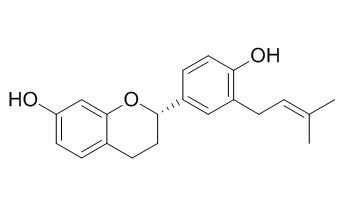Providing storage is as stated on the product vial and the vial is kept tightly sealed, the product can be stored for up to
24 months(2-8C).
Wherever possible, you should prepare and use solutions on the same day. However, if you need to make up stock solutions in advance, we recommend that you store the solution as aliquots in tightly sealed vials at -20C. Generally, these will be useable for up to two weeks. Before use, and prior to opening the vial we recommend that you allow your product to equilibrate to room temperature for at least 1 hour.
Need more advice on solubility, usage and handling? Please email to: service@chemfaces.com
The packaging of the product may have turned upside down during transportation, resulting in the natural compounds adhering to the neck or cap of the vial. take the vial out of its packaging and gently shake to let the compounds fall to the bottom of the vial. for liquid products, centrifuge at 200-500 RPM to gather the liquid at the bottom of the vial. try to avoid loss or contamination during handling.
J Nat Prod. 2001 Oct;64(10):1286-93.
Aromatase inhibitors from Broussonetia papyrifera.[Pubmed:
11678652]
METHODS AND RESULTS:
Bioassay-guided fractionation of an ethyl acetate-soluble extract from the whole plants of Broussonetia papyrifera, using an in vitro aromatase inhibition assay, led to the isolation of five new active compounds, 5,7,2',4'-tetrahydroxy-3-geranylflavone (1), isogemichalcone C (8), 3'-[gamma-hydroxymethyl-(E)-gamma-methylallyl]-2,4,2',4'-tetrahydroxychalcone 11'-O-coumarate (9), demethylmoracin I (10), and (2S)-2',4'-dihydroxy-2' '-(1-hydroxy-1-methylethyl)dihydrofuro[2,3-h]flavanone (11), and 10 known (12-21) compounds which were also found to be active.
CONCLUSIONS:
Of these compounds, the most potent were 9 (IC(50) 0.5 microM), 11 (IC(50) 0.1 microM), isolicoflavonol (12, IC(50) 0.1 microM), and (2S)-abyssinone II (13, IC(50) 0.4 microM). Additionally, six new compounds, 5,7,3',4'-tetrahydroxy-6-geranylflavonol (2), 5,7,3',4'-tetrahydroxy-3-methoxy-6-geranylflavone (3), (2S)-7,4'-Dihydroxy-3'-prenylflavan (4), 1-(2,4-dihydroxyphenyl)-3-(4-hydroxyphenyl)propane (5), 1-(2,4-dihydroxy-3-prenylphenyl)-3-(4-hydroxyphenyl)propane (6), and 1-(4-hydroxy-2-methoxyphenyl)-3-(4-hydroxy-3-prenylphenyl)propane (7), were isolated and characterized, but proved to be inactive as aromatase inhibitors, as were an additional 21 known compounds. The structures of the new compounds (1-11) were elucidated by spectroscopic methods.



